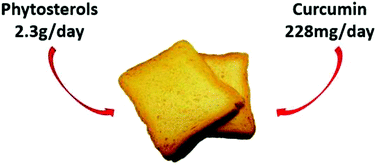Bread enriched with phytosterols with or without curcumin modulates lipoprotein profiles in hypercholesterolaemic individuals. A randomised controlled trial†
Abstract
We previously demonstrated that the combination of phytosterols (PS) and curcumin administered as dietary supplements significantly lowers LDL-cholesterol (LDL-C) more than either treatment alone. The aim of this study was to investigate the effects of this combination in a novel food (bread) on plasma lipid profiles in hypercholesterolaemic individuals. In a double-blinded, placebo-controlled, 2 × 2 factorial trial, participants were randomised to receive bread fortified with placebo (PL), 2.3 g PS (PS), 228 mg curcumin (CC) or a combination of 2.3 g PS and 228 mg CC (PS-CC) daily for four weeks. Primary outcomes were fasting plasma lipids [total cholesterol (TC), low-density lipoprotein cholesterol (LDL-C), high-density lipoprotein cholesterol (HDL-C) and triglycerides (TG)] and secondary outcomes were plasma LDL-particle (LDL-P) profile: LDL-P number and LDL-P size. Cardiovascular disease (CVD) risk (Framingham Risk Algorithm) was also explored. There was no significant difference between PL and CC or PS and PS-CC on blood lipids or CVD risk; therefore, groups were pooled for final analysis: the PL and CC group (PL-C, n = 36) and the PS and PS-CC group (PS-C, n = 39). PS-C significantly lowered TC (−0.52 mmol L−1, p < 0.0001), LDL-C (−0.49 mmol L−1, p < 0.0001) and CVD risk (−1.1 absolute %, p = 0.0005) compared to the PL-C group. Reductions from baseline in the PS-C group compared to that in the PL-C group were 7.6% and 10.6% for TC and LDL-C, respectively, and statistically significant (p < 0.0001). CVD-risk in the PS-C group reduced significantly (−12.7%) compared to that in the PL-C group (p = 0.0005). HDL-C and TG remained unchanged. The LDL-P number significantly decreased in the PS-C group by 124.33 nmol L−1 compared to that in the PL-C group (p = 0.005) and both groups showed a significant decrease in LDL-P size (p < 0.01); however, the absolute nm change in LDL-P size did not differ between groups and the percent change in LDL-P size in the PS-C group was borderline significant (−0.89%, p = 0.05) compared to that in the PL-C group. Regular consumption of PS-enriched bread with or without curcumin lowers blood cholesterol; however, curcumin alone did not influence blood lipids. Bread may be a convenient means of delivering PS with greater compliance for reducing the blood cholesterol concentration.



 Please wait while we load your content...
Please wait while we load your content...